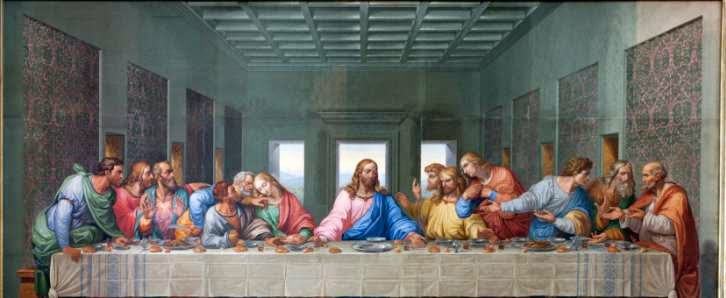Famous Art Pieces: "The Last Supper"
One of the most widely-recognized pieces of art in all of history is Leonardo Da Vinci's "The Last Supper."This painting portrays the last dinner or "supper" of Jesus Christ and his disciples as depicted in the Gospels. One of the defining works of the Renaissance period, Leonardo's "The Last Supper" has gone through major reconstruction, while serving as inspiration for countless other artists. It has also been the subject of intellectual and theological controversy. This article will examine the rich and fascinating history behind this historical painting, from commission to controversy.
The History of the Painting
"The Last Supper" was commissioned in 1495 by the Duke of Milan,
who was Leonardo Da Vinci's patron, and it was commissioned for the
monastery of Santa Maria Delle Grazie in Milan, Italy. The painting
covers an entire wall at the end of the dining hall, which was
originally a mausoleum. It measures 180-inches high and 350-inches long.
Leonardo's vision was to depict the reaction of each of the disciples,
as they were told that one of them would betray Christ. Completed in
1498, the painting was created not in the manner of a traditional fresco
on a wet plaster wall with watercolor, but it was done with oil paint
on a prepared dry wall, on which the painting could be altered as
needed. Unfortunately, this method meant that the masterpiece began to
deteriorate less than 20 years after its first unveiling.
Restoration Efforts
"The Last Supper" has gone through several major restoration
efforts over the last 500 years. Less than 60 years after it was
painted, the figures in "The Last Supper" were all but unrecognizable.
The first restoration effort began in 1726, with the missing sections
repainted in oil, and the entire piece was varnished for added
protection. Unfortunately, this effort did not prevent the painting from
further deterioration, and two more restoration projects nearly
destroyed the original painting. In 1978, Pinin Brambilla Barcilon began
a new restoration effort. The room in which the painting resides was
sealed and modified into a climate-controlled area. The painting was
permanently stabilized, and scientific methods were used to determine
the exact composition of the original work. The restoration of the
painting was completed in 1999, which was 21 years after the project
began.
Modern Mentions and Imitations of the Painting
"The Last Supper" has been copied many times. One copy resides
at the Royal Academy of Arts, and it was painted by Giampietrino, who
was believed to be one of Leonardo's assistants. Another famous copy of
the painting is a relief created in salt at the Wieliczka Salt Mine. In
addition to these copies, the painting has served as inspiration for
several famous modern works as well. In 1955, for example, Salvador Dali
painted "The Sacrament of the Last Supper," which was an interpretation
of Leonardo's masterpiece. Another famous interpretation of this
painting was created by the famous artist Andy Warhol, as part of his
final series of paintings.
Controversy Surrounding the Painting
In 2003, author Dan Brown released his now infamous novel, "The
Da Vinci Code." In this book, a number of conspiracies revolving around
Leonardo Da Vinci, his work, and a fictitious group called the Priory of
Scion were portrayed as fact. These conspiracies were based around the
central theme that the mythical Holy Grail of religious lore was not in
fact a cup, as had previously been believed; instead, it was the
biblical figure Mary Magdalene, who Brown claimed was the wife of
Christ. The book asserts that "The Last Supper" held clues to the
Grail's true identity. Although Brown's book was not the first to make
such claims, it received more media attention than previous works.
However, these claims have been thoroughly denied by the Catholic
Church.
Though Leonardo Da Vinci created many more works of art in his time, "The Last Supper" is one of his most widely recognized paintings, and in close second is the "Mona Lisa." This is supported by the thousands of visitors who come to the Church of Santa Maria Delle Grazie in Milan each year to view the painting in person. Whether you are drawn in by the conspiracies surrounding "The Last Supper" or simply by its beauty, the fact remains that Leonardo's masterpiece is a wonder to behold. Ravaged by time, and never fully restored to its original glory, "The Last Supper" will carry its mysteries to the end of eternity.
Though Leonardo Da Vinci created many more works of art in his time, "The Last Supper" is one of his most widely recognized paintings, and in close second is the "Mona Lisa." This is supported by the thousands of visitors who come to the Church of Santa Maria Delle Grazie in Milan each year to view the painting in person. Whether you are drawn in by the conspiracies surrounding "The Last Supper" or simply by its beauty, the fact remains that Leonardo's masterpiece is a wonder to behold. Ravaged by time, and never fully restored to its original glory, "The Last Supper" will carry its mysteries to the end of eternity.


No comments:
Post a Comment